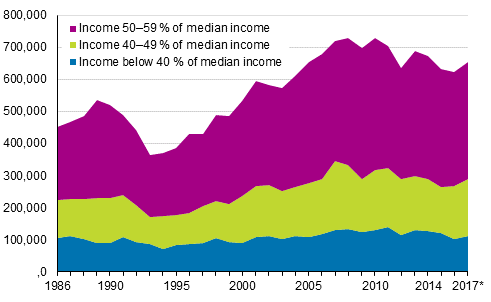Published: 19 December 2018
Number of persons at risk of poverty grew in 2017
Statistics Finland's income distribution statistics indicate that the number of persons belonging to households at risk of poverty was 654,000 in 2017. The share of persons at risk of poverty in the household population was 12.1 per cent, which is 0.6 percentage points more than in the previous year. Then the number of persons belonging to households at risk of poverty was 623,000.
Number of persons at risk of poverty in Finland in 1986 to 2017*.

Income concept: equivalent disposable money income (excl. capital gains). The data concerning 2017 are preliminary.
The relative risk of poverty has varied in the past ten years between 623,000 and 728,000 persons, when the used at-risk-of-poverty threshold is 60 per cent of median income. In 2017, the at-risk-of-poverty threshold was EUR 14,750 per year for one-person households, that is, around EUR 1,230 per month.
At-risk-of-poverty indicator describes the relative income differentials of medium-income and low-income groups. The development of number of persons at risk of poverty depends also on the development of median income, not only on the income development of low-income households. Persons are classified as being at-risk-of-poverty when the household's disposable monetary income per consumption unit 1) is below 60 per cent of the national median income. Households’ median income from which the at-risk-of-poverty threshold is counted, was EUR 24,580 for a one-person household in 2017.
Number of persons with difficulties in making ends meet decreased
A total of 605,000 households, or 22.3 per cent of all households, experienced at least some difficulties in making ends meet in 2017. The number of households experiencing at least some difficulties went down by 60,000 households. The number of households experiencing more serious difficulties went down and was 189,000, that is, 7.0 per cent of all households. One year earlier, the number of households experiencing more serious difficulties in making ends meet was 198,000, that is, 7.4 per cent of all households.
The share of households experiencing difficulties has varied between seven and eight per cent after 2010. However, the share in 2017 was the smallest one in the measurement period starting in 2003.
1) The consumption units are based on the so-called OECD's modified scale. One adult in the household is one consumption unit. Other persons in the household aged at least 14 each are 0.5 consumption units and children aged 0 to 13 each are 0.3 consumption units. A household with one adult member is one consumption unit, while a household consisting of spouses and one child aged under 14 together are 1.8 consumption units.
Source: Income Distribution Statistics 2017, Statistics Finland
Inquiries: Kaisa-Mari Okkonen 029 551 3408
Director in charge: Jari Tarkoma
- Tables
-
Tables in databases
Pick the data you need into tables, view the data as graphs, or download the data for your use.
Appendix tables
- Quality descriptions
-
- Quality report: Income Distribution Statistics (19.12.2018)
Updated 19.12.2018
Official Statistics of Finland (OSF):
Income distribution statistics [e-publication].
ISSN=1799-1331. Income inequality (international comparison) 2017. Helsinki: Statistics Finland [referred: 28.12.2025].
Access method: http://stat.fi/til/tjt/2017/01/tjt_2017_01_2018-12-19_tie_001_en.html

